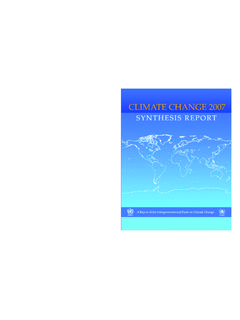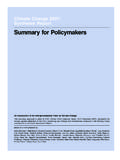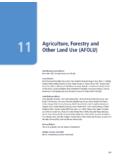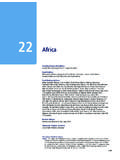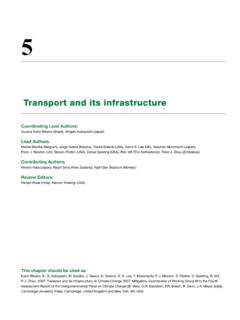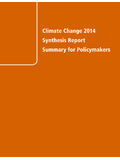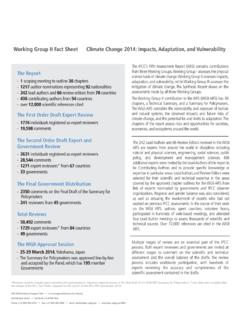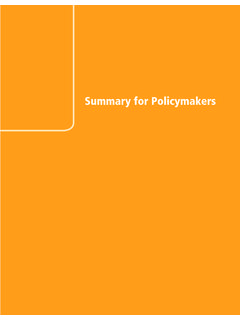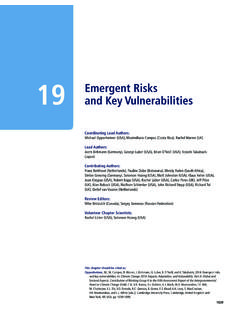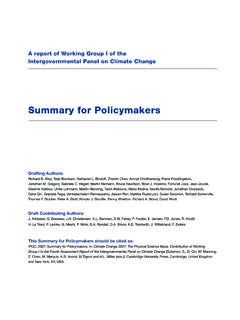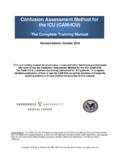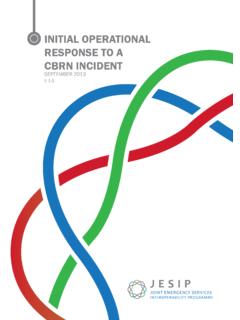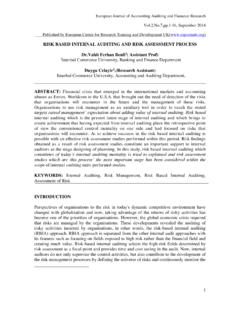Transcription of Energy Systems - IPCC
1 7 Energy Systems Coordinating Lead Authors: Thomas Bruckner (Germany), Igor Alexeyevich Bashmakov (Russian Federation), Yacob Mulugetta (Ethiopia / UK). Lead Authors: Helena Chum (Brazil / USA), Angel De la Vega Navarro (Mexico), James Edmonds (USA), Andre Faaij (Netherlands), Bundit Fungtammasan (Thailand), Amit Garg (India), Edgar Hertwich (Austria / Norway), Damon Honnery (Australia), David Infield (UK), Mikiko Kainuma (Japan), Smail Khennas (Algeria / UK), Suduk Kim (Republic of Korea), Hassan Bashir Nimir (Sudan), Keywan Riahi (Austria), Neil Strachan (UK), Ryan Wiser (USA), Xiliang Zhang (China). Contributing Authors: Yumiko Asayama (Japan), Giovanni Baiocchi (UK / Italy), Francesco Cherubini (Italy / Norway), Anna Czajkowska (Poland / UK), Naim Darghouth (USA), James J.
2 Dooley (USA), Thomas Gibon (France / Norway), Haruna Gujba (Ethiopia / Nigeria), Ben Hoen (USA), David de Jager (Netherlands), Jessica Jewell (IIASA / USA), Susanne Kadner (Germany), Son H. Kim (USA), Peter Larsen (USA), Axel Michaelowa (Germany / Switzerland), Andrew Mills (USA), Kanako Morita (Japan), Karsten Neuhoff (Germany), Ariel Macaspac Hernandez (Philippines / Germany), H-Holger Rogner (Germany), Joseph Salvatore (UK), Steffen Schl mer (Germany), Kristin Seyboth (USA), Christoph von Stechow (Germany), Jigeesha Upadhyay (India). Review Editors: Kirit Parikh (India), Jim Skea (UK). Chapter Science Assistant: Ariel Macaspac Hernandez (Philippines / Germany).
3 511. Energy Systems Chapter 7. This chapter should be cited as: Bruckner T., I. A. Bashmakov, Y. Mulugetta, H. Chum, A. de la Vega Navarro, J. Edmonds, A. Faaij, B. Fungtammasan, A. Garg, E. Hertwich, D. Honnery, D. Infield, M. Kainuma, S. Khennas, S. Kim, H. B. Nimir, K. Riahi, N. Strachan, R. Wiser, and X. Zhang, 2014: Energy Systems . In: Climate Change 2014: Mitigation of Climate Change. Contribution of Working Group III to the Fifth Assessment Report of the Intergovernmental Panel on Climate Change [Edenhofer, O., R. Pichs-Madruga, Y. Sokona, E. Farahani, S. Kadner, K. Seyboth, A. Adler, I. Baum, S. Brunner, P.]
4 Eickemeier, B. Kriemann, J. Savolainen, S. Schl mer, C. von 7 Stechow, T. Zwickel and Minx (eds.)]. Cambridge University Press, Cambridge, United Kingdom and New York, NY, USA. 512. Chapter 7 Energy Systems Contents Executive Summary 482. 7. Introduction 518. Energy production, conversion, transmission and distribution 519. New developments in emission trends and drivers 522. Resources and resource availability 524. Fossil fuels 524. Renewable Energy 525. Nuclear Energy 526. Mitigation technology options, practices and behavioral aspects 527. Fossil fuel extraction, conversion, and fuel switching 527. Energy efficiency in transmission and distribution 528.
5 Renewable Energy technologies 528. Nuclear Energy 530. Carbon dioxide capture and storage (CCS) 532. Infrastructure and systemic perspectives 534. Electrical power Systems 534. system balancing flexible generation and loads 534. Capacity adequacy 535. Transmission and distribution 535. Heating and cooling networks 535. Fuel supply Systems 536. CO2 transport 536. 513. Energy Systems Chapter 7. Climate change f eedback and interaction with adaptation 537. Costs and potentials 538. Potential emission reduction from mitigation measures 538. 7. Cost assessment of mitigation measures 542. Economic potentials of mitigation measures 543.
6 Co-benefits, risks and spillovers 544. Socio-economic effects 544. Environmental and health effects 546. Technical risks 549. Public perception 551. Barriers and opportunities 551. Technical aspects 551. Financial and investment barriers and opportunities 552. Cultural, institutional, and legal barriers and opportunities 552. Human capital capacity building 553. Inertia in Energy Systems physical c apital stock turnover 553. Sectoral i mplication of transformation p athways and sustainable development 554. Energy -related greenhouse gas emissions 554. Energy supply in low-stabilization scenarios 555. Role of the electricity sector in climate change mitigation 559.
7 Relationship between short-term action and long-term targets 562. 514. Chapter 7 Energy Systems Sectoral policies 564. Economic instruments 565. Regulatory approaches 567. Information programmes 567 7. Government provision of public goods or services 567. Voluntary actions 568. Gaps in knowledge and data 568. Frequently Asked Questions 568. References 570. 515. Energy Systems Chapter 7. Executive Summary toward zero in the long term. Improving the Energy efficiencies of fos- sil power plants and / or the shift from coal to gas will not by itself be sufficient to achieve this. Low-GHG Energy supply technologies are The Energy Systems chapter addresses issues related to the found to be necessary if this goal is to be achieved.
8 [ , , mitigation of greenhouse gas emissions (GHG) from the Energy ]. supply sector. The Energy supply sector, as defined in this report, 7 comprises all Energy extraction, conversion, storage, transmission, and Decarbonizing (i. e. reducing the carbon intensity of) electric- distribution processes that deliver final Energy to the end-use sectors ity generation is a key component of cost-effective mitigation (industry, transport, and building, as well as agriculture and forestry). strategies in achieving low-stabilization levels (430 530 ppm Demand side measures in the Energy end-use sectors are discussed in CO2eq); in most integrated modelling scenarios, decarboniza- chapters 8 11.
9 Tion happens more rapidly in electricity generation than in the industry, buildings and transport sectors (medium evidence, high The Energy supply sector is the largest contributor to global agreement). In the majority of low-stabilization scenarios, the share greenhouse gas emissions (robust evidence, high agreement). In of low-carbon electricity supply (comprising RE, nuclear and CCS). 2010, the Energy supply sector was responsible for approximately 35 % increases from the current share of approximately 30 % to more than of total anthropogenic GHG emissions. Despite the United Nations 80 % by 2050, and fossil fuel power generation without CCS is phased Framework Convention on Climate Change (UNFCCC) and the Kyoto out almost entirely by 2100.
10 [ ]. Protocol, GHG emissions grew more rapidly between 2000 and 2010. than in the previous decade. Annual GHG-emissions growth in the global Since the Intergovernmental Panel on Climate Change (IPCC). Energy supply sector accelerated from % per year from 1990 2000 Fourth Assessment Report (AR4), many RE technologies have to % per year from 2000 2010. The main contributors to this trend demonstrated substantial performance improvements and cost were a higher Energy demand associated with rapid economic growth reductions, and a growing number of RE technologies have and an increase of the share of coal in the global fuel mix.
